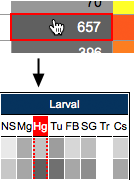FlyAtlas 2 – Gene
For a particular Drosophila gene, find the pattern of expression in different tissues.
Gene Symbol (e.g. vkg) — start typing, then select from the autosuggest menu
Gene Name (e.g. viking)
Annotation Symbol (e.g. CG16858)
Gene ID (e.g. FBgn0016075)
Transcript ID (e.g. FBtr0079036)
Gene Name (e.g. viking)
Annotation Symbol (e.g. CG16858)
Gene ID (e.g. FBgn0016075)
Transcript ID (e.g. FBtr0079036)
Gene:
| Adult Male | Adult Female | Male v. Female | Larval | |||||
|---|---|---|---|---|---|---|---|---|
| Tissue | FPKM | Enrichment | FPKM | Enrichment | M/F | p value | FPKM | Enrichment |
| Head | 11 ± 1.0 | 1.4 | 11 ± 1.5 | 0.6 | 1.03 | n.s. | ||
| Eye | 9.9 ± 0.3 | 1.2 | 8.5 ± 0.6 | 0.5 | 1.16 | n.s. | ||
| Brain / CNS | 15 ± 0.6 | 1.9 | 14 ± 1.2 | 0.7 | 1.11 | n.s. | 23 ± 2.4 | 4.1 |
| Thoracicoabdominal ganglion | 9.7 ± 0.7 | 1.2 | 11 ± 0.0 | 0.6 | 0.88 | n.s. | ||
| Crop | 7.6 ± 0.1 | 0.9 | 6.5 ± 2.3 | 0.4 | 1.18 | n.s. | ||
| Midgut | 10 ± 0.3 | 1.3 | 5.8 ± 0.5 | 0.3 | 1.80 | p < 0.01 | 5.6 ± 0.8 | 1.0 |
| Hindgut | 7.0 ± 0.3 | 0.9 | 7.9 ± 0.2 | 0.4 | 0.89 | p < 0.05 | 5.0 ± 0.8 | 0.9 |
| Malpighian Tubules | 8.3 ± 1.2 | 1.0 | 8.3 ± 0.6 | 0.4 | 1.01 | n.s. | 5.3 ± 0.9 | 1.0 |
| Rectal pad | 5.8 ± 0.8 | 0.7 | 6.0 ± 0.0 | 0.3 | 0.97 | n.s. | ||
| Salivary gland | 10 ± 0.2 | 1.3 | 11 ± 2.6 | 0.6 | 0.97 | n.s. | 12 ± 1.1 | 2.1 |
| Fat body | 6.1 ± 0.9 | 0.7 | 8.2 ± 0.5 | 0.4 | 0.74 | p < 0.05 | 8.3 ± 0.8 | 1.5 |
| Heart | 7.9 ± 1.4 | 1.0 | 14 ± 6.9 | 0.8 | 0.57 | n.s. | ||
| Trachea | 11 ± 0.4 | 2.0 | ||||||
| Ovary | 22 ± 0.5 | 1.2 | ||||||
| Virgin Spermatheca | 9.7 ± 1.5 | 0.5 | ||||||
| Mated Spermatheca | 10 ± 1.9 | 0.6 | ||||||
| Testis | 8.0 ± 0.6 | 1.0 | ||||||
| Accessory glands | 12 ± 0.5 | 1.4 | ||||||
| Carcass | 6.2 ± 0.5 | 0.8 | 8.0 ± 1.1 | 0.4 | 0.77 | n.s. | 7.1 ± 0.1 | 1.3 |
| Garland cells | 9.5 ± 1.7 | 1.7 | ||||||
| Whole body | 8.2 ± 0.4 | 18 ± 1.8 | 0.44 | p < 0.01 | 5.5 ± 0.5 | |||

Rotate to see Transcript Table
| Transcript | Male | Female | Larval | ||||||||||||||||||||||||||||||||||||||
|---|---|---|---|---|---|---|---|---|---|---|---|---|---|---|---|---|---|---|---|---|---|---|---|---|---|---|---|---|---|---|---|---|---|---|---|---|---|---|---|---|---|
| Name | ID | Hd | Ey | Br | Tg | Cr | Mg | Hg | Tu | Rp | Sg | Fb | Ht | Ts | Ag | Cs | Hd | Ey | Br | Tg | Cr | Mg | Hg | Tu | Rp | Sg | Fb | Ht | Ov | Vs | Ms | Cs | Ns | Mg | Hg | Tu | Sg | Fb | Tr | Cs | Ga |
| RA | FBtr0072932 | ||||||||||||||||||||||||||||||||||||||||
| RB | FBtr0072933 | ||||||||||||||||||||||||||||||||||||||||
| RC | FBtr0072931 | ||||||||||||||||||||||||||||||||||||||||
| RD | FBtr0072934 | ||||||||||||||||||||||||||||||||||||||||
| RE | FBtr0072936 | ||||||||||||||||||||||||||||||||||||||||
| RF | FBtr0072935 | ||||||||||||||||||||||||||||||||||||||||
| RG | FBtr0290340 | ||||||||||||||||||||||||||||||||||||||||

All or part of these data are equivocal because the protein encoded by this gene is translated from the same di- or poly-cistronic mRNA as that for gene FBgn0250911 (see Docs: Questions and Problems).
For detailed information, consult the FlyBase entry for the gene (link above, or for transcripts, at the left). If the gene has several transcripts it is possible that one or more of them may be unique and have valid data.
For detailed information, consult the FlyBase entry for the gene (link above, or for transcripts, at the left). If the gene has several transcripts it is possible that one or more of them may be unique and have valid data.
*Tissue Comparability:
See Docs for info on the chemistry used to sequence different tissues.
See Docs for info on the chemistry used to sequence different tissues.

